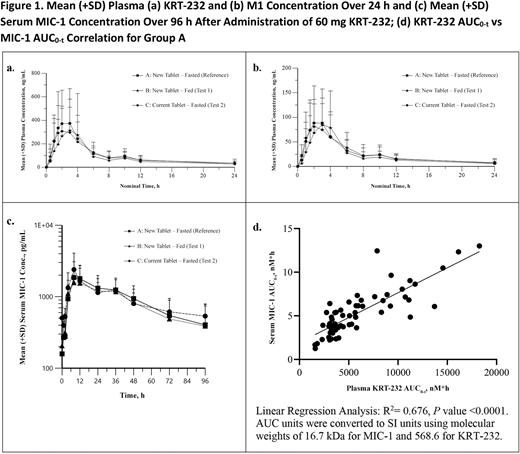Background: KRT-232 is a potent, selective, orally available, small-molecule drug that binds to mouse double minute 2 homolog (MDM2) and inhibits its interactions with tumor suppressor protein p53. KRT-232 is under development for treatment of myeloproliferative neoplasms, acute myeloid leukemia, and Merkel cell carcinoma. Increased serum MIC-1 (pg/mL) is a pharmacodynamic (PD) marker of p53-mediated activity in patients treated with KRT-232 (Allard,HemaSphere, 2020;4:S1, Abstract EP519). The aim of this study was to assess the safety and effect of a high-fat meal on KRT-232 pharmacokinetics (PK) and MIC-1 PD of a new tablet formulation in healthy volunteers. This is the first characterization of a MDM2-inhibitor-induced MIC-1 response in healthy volunteers.
Methods: KRT-232-105 was a single-center, open-label, 60-mg single-dose, 3-treatment, 4-period, and 3-sequence study with a partial replicate crossover design. Volunteers (N=30) were randomized to three treatment groups: A: new tablet, fasted (reference, dosed twice in Periods 2-4); B: new tablet, 30 min after a high-fat, high-calorie meal (test 1, dosed once in periods 2-4); C: current tablet, fasted (test 2, period 1 only). Plasma KRT-232, its acyl glucuronide metabolite (M1) and serum MIC-1 concentrations were measured over 0-96 h. Urine from group C was collected over 0-48 h. Doses were one week apart. All volunteers had aH pyloribreath test and were genotyped for UGT1A1*28 polymorphisms.
Results: Volunteers were 43% female, 7% African American and 77% Hispanic/Latino. Mean age was 38.1 y (range, 18-54), and mean body mass index was 26.9 kg/m2 (range, 21.4-30.9). No deaths, serious adverse events (SAEs), or discontinuations were reported. Twenty-one treatment-emergent AEs (TEAEs) were observed in 13 (43%) volunteers; constipation was the most frequent AE, followed by headache. All TEAEs were grade 1 (n=17) or grade 2 (n=4: 1 headache event [possibly study drug-related] and 3 events of headache, influenza-like illness, and pharyngitis).
Mean (SD) concentration-time plots of KRT-232 and M1 were similar across the 3 groups (Figure 1a and b). A second peak was observed, consistent with enterohepatic recirculation.
With a meal (test 1), KRT-232 geometric least-squares mean (GLSM) maximum concentration (Cmax) was similar (431 and 442 ng/mL (GLSM ratio [90% CI], 103% [87.4-121]) and KRT-232 GLSM area under the curve (AUC0-t) decreased from 2858 to 2325 ng∙h/mL (GLSM ratio [90% CI], 81.4 [76.2-86.9]). Median time of Cmax (Tmax) was 2 h fasted and 3 h fed. Geometric mean half life (t1/2) was unchanged (17.0 vs 17.1 h).
Under fasting conditions, the current tablet (C, test 2) vs new tablet (A, reference), KRT-232 GLSM Cmax decreased from 431 to 337 ng/mL (GLSM ratio [90% CI], 78.4% [72.0-85.3]) and KRT-232 GLSM AUC0-t had a possible small decrease (2858 and 2455 ng∙h/mL, GLSM ratio [90% CI], 85.9 [80.5-91.7]). Median Tmax (~2 h) and geometric mean t1/2 (17 h) were unchanged. The fraction of the KRT-232 dose in urine as KRT-232 and M1 was negligible at 0.0201% and 0.0220% of dose, respectively.
KRT-232 is a carboxylic acid with pH-dependent solubility that increases with increasing pH.H pyloriinfection, which can increase stomach pH, did not have any discernable impact on KRT-232 PK.
KRT-232 and M1 exposure in heterozygous UGT1A1*28 poor metabolizers (6/7 TA repeats, N=16) was generally comparable to exposure in wild-type (WT) UGT1A1*28 (6/6 TA repeats, N=12) subjects.
MIC-1 concentrations in serum were variable and followed the PK time course with a median Tmax lag of ~8-12 h. Group A: Mean Cmax 2115 pg/mL, C0 (Baseline) 170 pg/mL, AUC0-T 89267 pg*h/mL and mean t1/2 27 h. MIC-1 Cmax and AUC were generally comparable over 96 h across groups (Figure 1c).Figure 1dshows the statistically significant correlation between KRT-232 AUC0-t and MIC-1 AUC0-t.
Conclusions: Based on generally comparable PK, KRT-232 can be administered with or without food, and no dose adjustment is warranted with a new tablet formulation. KRT-232 PK was not affected byH pylori, inferring that higher gastric pH did not alter absorption of KRT-232. KRT-232 exposure in UGT1A1*28 heterozygous poor metabolizers was generally comparable to WT UGT1A1*28 wild type healthy volunteers. The 60-mg KRT-232 dose elicited a reproducible and robust MIC-1 response that correlated with KRT-232 exposure, indicating MDM2-p53 target engagement.
Wong:Kartos Therapeutics:Current Employment;AbbVie Biotherapeutics:Ended employment in the past 24 months.Krejsa:Kartos Therapeutics:Current Employment;AstraZeneca:Current equity holder in publicly-traded company;Seattle Genetics:Current equity holder in publicly-traded company;Acerta Pharma:Current equity holder in private company.Lee:Kartos Therapeutics:Current Employment.Harris:Gilead Sciences:Current equity holder in publicly-traded company;Kartos Therapeutics:Current Employment, Current equity holder in private company;BeiGene:Ended employment in the past 24 months;Clovis:Current equity holder in publicly-traded company, Ended employment in the past 24 months.Simard:Certara:Current Employment;AltaScience:Ended employment in the past 24 months.Wang:Certara:Current Employment.Rubets:Certara:Current Employment.Allard:Certara:Consultancy, Ended employment in the past 24 months;CytomX Therapeutics:Ended employment in the past 24 months;Telios Pharma:Current Employment, Current equity holder in private company.Podoll:IV/PO, LLC:Consultancy.O'Reilly:Celerion:Current Employment.Slatter:Amgen:Divested equity in a private or publicly-traded company in the past 24 months;Kartos Therapeutics:Current Employment;AstraZeneca:Current equity holder in publicly-traded company.
Yes, KRT-232 is an investigational small molecule MDM2 inhibitor.
Author notes
Asterisk with author names denotes non-ASH members.


This feature is available to Subscribers Only
Sign In or Create an Account Close Modal